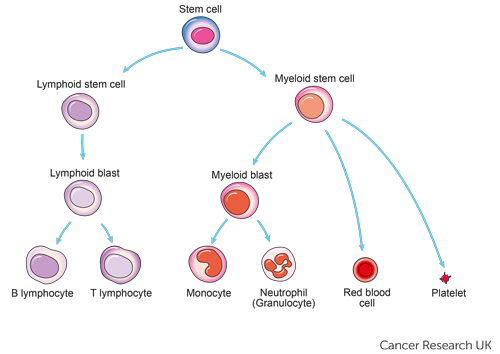- Acute Myeloid Leukemia
Overview
Normally our bone marrow makes blood stem cells, also called immature cells. In time, blood stem cells mature and become either Myeloid stem cells or Lymphoid stem cells.
If you have an AML diagnosis, your Myeloid stem cells, seen here in orange, do not mature into healthy white blood cells. In addition, sometimes in AML, too many stem cells become abnormal red blood cells or platelets. These abnormal white blood cells, red blood cells, or platelets are all called leukemia cells.
What Tests Will I Need and Why?
Blood and Imaging tests are done to understand your general health and confirm your diagnosis.
Tissue analysis in the form of a bone marrow biopsy and sometimes also a sample of spine liquid is done to determine the type of AML.
If your treatment team has not already performed tests to determine your cancer’s features, please ask your doctor when these tests will be performed. This information is critical to finding the best treatment option for you given your goals and lifestyle needs.
Re-read this summary as needed and then tap, “Compare My Treatment Options Now“. Our unique Comparison Page will help you understand your FDA-approved treatment options including, who can help you pay for your treatment, where and how each is given and what side-effects you may experience.

National Institute of Health/ treatment-leukemia
Recommended Leukemia Cancer Videos

What Is Blood Cancer
Brought To You By Black Health Matters

Leukemia Causes, Signs and Symptoms
What is Leukemia?

How Cancer Spreads
Metastastis

Diagnosing Your Cancer
How Does a CT Scan Work?

Diagnosing Your Cancer
How Does a PET Scan Work?

Exercise! You Can Do It
Reducing Side Effects & More
Commonly Searched Questions
Acute Myeloid Leukemia (AML) Definition
Source: Cancer.org
Acute Myeloid Leukemia (AML) Survival Rate
Source: Cancer.gov
Acute Myeloid Leukemia (AML) Symptoms
- weakness
- fever
- infection
- paleness or loss of normal skin color
- bleeding
Source: www.cancer.gov
Acute Myeloid Leukemia (AML) Treatment
- Chemotherapy
- Radiation therapy
- Chemotherapy with stem cell transplant
- Targeted therapy
- Other drug therapy
Source: www.cancer.gov
Acute Myeloid Leukemia (AML) Recurrence Rate
- Children and Young Adults: The recurrence rate for AML in children and young adults can be around 30-40%.
- Adults: The recurrence rate in adults is generally higher, with about 40-60% of patients experiencing relapse.
Source: www.cancer.gov
Acute Myeloid Leukemia (AML) Prevention
- Avoid Unnecessary Exposure to Radiation: Limit exposure to high levels of radiation, including certain medical treatments and environmental sources.
- Limit Exposure to Certain Chemicals: Reduce exposure to industrial chemicals and solvents known to increase cancer risk, such as benzene.
- Healthy Lifestyle Choices: Maintain a healthy diet, exercise regularly, and avoid smoking, as overall health can influence cancer risk.
- Manage Existing Health Conditions: Properly manage chronic conditions that may increase cancer risk, such as certain genetic disorders or blood disorders.
Source: www.cancer.gov














